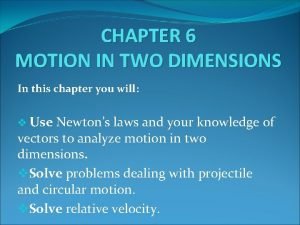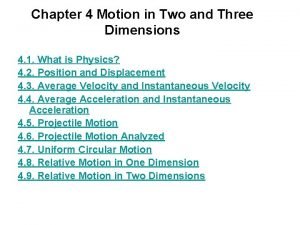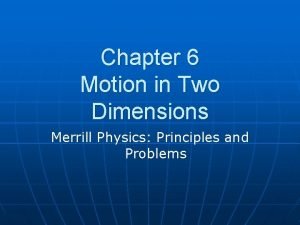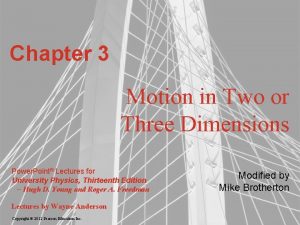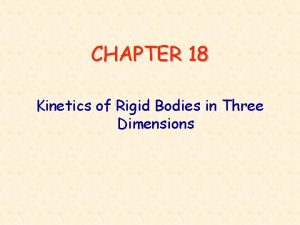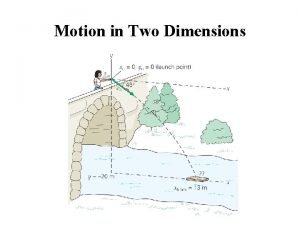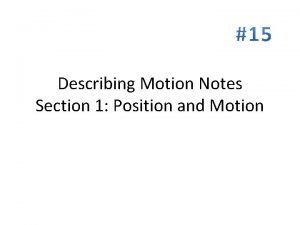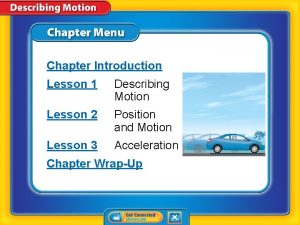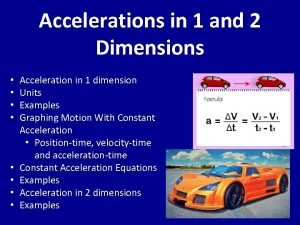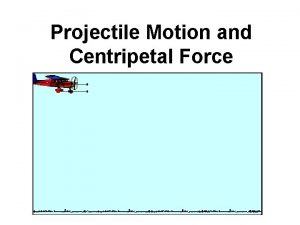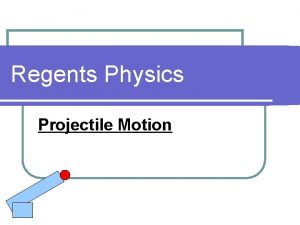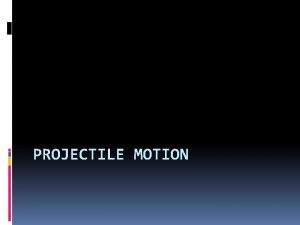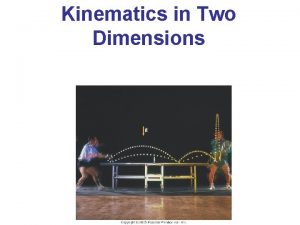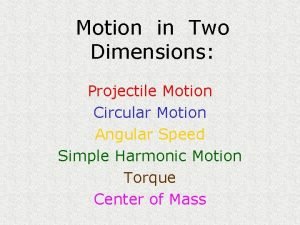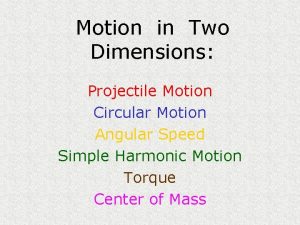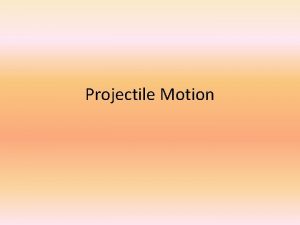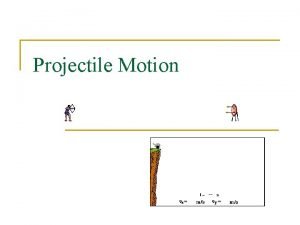Projectile Motion Motion in Two Dimensions A projectile


















- Slides: 18

Projectile Motion

Motion in Two Dimensions A projectile is an object moving in two dimensions under the influence of Earth's gravity; its path is a parabola.


Projectile Motion �Projectile Motion of an object that is projected into the air at an angle. �Near the Earth’s surface, the acceleration a on the projectile is downward and equal to a = g = - 9. 8 m/s 2 �Goal: Describe motion after it starts. �Galileo: Analyzed horizontal & vertical components of motion separately. �Remember: Displacement D & velocity v are vectors Components of motion can be treated separately

The speed in the x-direction is constant; in the y-direction the object moves with constant acceleration g. Photo shows two balls that start to fall at the same time. The on the right has an initial speed in the x-direction. It can be seen that vertical positions of the two balls are identical at identical times, while the horizontal position of the yellow ball increases linearly.

Projectile Motion �Simplest example: A ball rolls across a table, to the edge & falls off the edge to the floor. It leaves the table at time t = 0. Analyze the y part of motion & the x part of motion separately. �y part of motion: Up is positive & the origin is at table top: y 0 = 0. Initially, there is no y component of velocity: vy 0 = 0 vy = - gt, y = - (½)g t 2 �x part of motion: The origin is at the table top: x 0 = 0. No x component of acceleration(!): a = 0. Initially the x component of velocity is: vx 0 vx = vx 0 , x = vx 0 t

Ball Rolls Across Table & Falls Off t = 0 here Can be understood by analyzing horizontal vertical motions separately. Take up as positive. Initial velocity has an x component ONLY! That is vy 0 = 0. At any point, v has both x & y components. Kinematic equations tell us that, at time t, vx = vx 0, vy = - gt x = vx 0 t, y = - (½)gt 2

�Summary: Ball rolling across table & falling. �Vector velocity v has 2 components: vx = vx 0 , vy = - gt �Vector displacement D has 2 components: x = vx 0 t , y = - (½)g t 2

Projectile Motion �PHYSICS: y part of motion: vy = - gt , y = - (½)g t 2 The SAME as free fall motion!! An object projected horizontally will reach the ground at the same time as an object dropped vertically from the same point! (x & y motions are independent)

General Case: Object is launched at initial angle θ 0 with the horizontal. Analysis is similar to before, except the initial velocity has a vertical component vy 0 0. Let up be positive now! vx 0 = v 0 cosθ 0 , vy 0 = v 0 sinθ 0 but, acceleration = g downward for the entire motion! LLLL Parabolic shape of path is real (neglecting air resistance!)

�General Case: Take y positive upward & origin at the point where it is shot: x 0 = y 0 = 0 vx 0 = v 0 cosθ 0, vy 0 = v 0 sinθ 0 �Horizontal motion: NO ACCELERATION IN THE x DIRECTION! vx = vx 0 , x = vx 0 t �Vertical motion: vy = vy 0 - gt , y = vy 0 t - (½)g t 2 (vy) 2 = (vy 0)2 - 2 gy � If y is positive downward, the - signs become + signs. ax = 0, ay = -g = -9. 8 m/s 2

Summary: Projectile Motion Projectile motion is motion with constant acceleration in two dimensions, where the acceleration is g and is down.

Solving Problems Involving Projectile Motion 1. Read the problem carefully, &choose the object(s) you are going to analyze. 2. Sketch a diagram. 3. Choose an origin & a coordinate system. 4. Decide on the time interval; this is the same in both directions, & includes only the time the object is moving with constant acceleration g. 5. Solve for the x and y motions separately. 6. List known & unknown quantities. Remember that vx never changes, & that vy = 0 at the highest point. 7. Plan how you will proceed. Use the appropriate equations; you may have to combine some of them.

Example: Driving off a cliff!! A movie stunt driver on a motorcycle speeds horizontally off a 50. 0 -m-high cliff. How fast must the motorcycle leave the cliff top to land on level ground below, 90 m from the base of the cliff where the cameras are? vx = vx 0 = ? vy = -gt x = vx 0 t, y = - (½)gt 2 Time to Bottom: t = √ 2 y/(-g) = 3. 19 s vx 0 = (x/t) = 28. 2 m/s y is positive upward, y 0 = 0 at top. Also vy 0 = 0


Example: Kicked football �A football is kicked at an angle θ 0 = 37. 0° with a velocity of 20. 0 m/s, as shown. Calculate: a. Max height. b. Time when hits ground. c. Total distance traveled in the x direction. d. Velocity at top. e. Acceleration at top. θ 0 = 37º, v 0 = 20 m/s vx 0= v 0 cos(θ 0) = 16 m/s, vy 0= v 0 sin(θ 0) = 12 m/s


 Chapter 6 assessment physics
Chapter 6 assessment physics A 45-kg merry-go-round worker
A 45-kg merry-go-round worker Chapter 6 motion in two dimensions
Chapter 6 motion in two dimensions Motion in two and three dimensions
Motion in two and three dimensions Chapter 6 motion in two dimensions
Chapter 6 motion in two dimensions Motion in two or three dimensions
Motion in two or three dimensions Motion in two dimensions quick check
Motion in two dimensions quick check A cart slows down while moving away from the origin
A cart slows down while moving away from the origin Examples of projectile motion
Examples of projectile motion Define projectile motion in physics
Define projectile motion in physics Kinetics of rigid body
Kinetics of rigid body Vy=gt
Vy=gt Two dimensions of political ideologies
Two dimensions of political ideologies Vertical velocity formula
Vertical velocity formula Describing position in two dimensions
Describing position in two dimensions Position and motion lesson 1
Position and motion lesson 1 Acceleration in two dimensions
Acceleration in two dimensions 2 dimensional media
2 dimensional media Chapter 5 displacement and force in two dimensions
Chapter 5 displacement and force in two dimensions


